Published on : Oct 26, 2017
Category : Events
After a great start and some great content on
Day 1 at Integrate 2017 USA it was time for the keynote, Jim Harrer returned to introduce the man known as ScottGu, the man in the red shirt.
Fresh off the back of his Red Shirt Tour, Scott Guthrie took to the stage to deliver a presentation to wrap up Day 1 of Integrate 2017 USA.
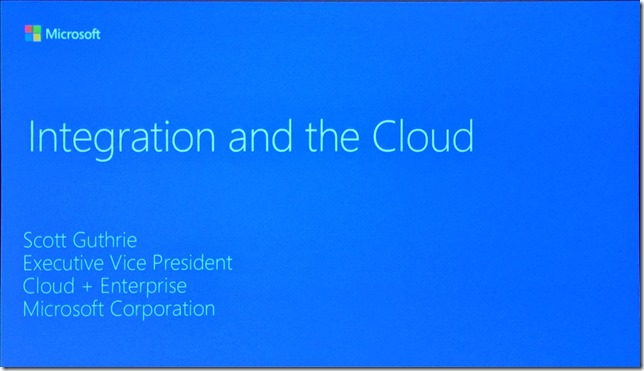
He started by asking the question, what are the big opportunities for integration?
He echoed Jim’s sentiment earlier in the day that integration is the glue and an essential part of any enterprise solution.
As
Integrate 2017 USA is a technical conference, he wanted to show some buzzwords and terms.
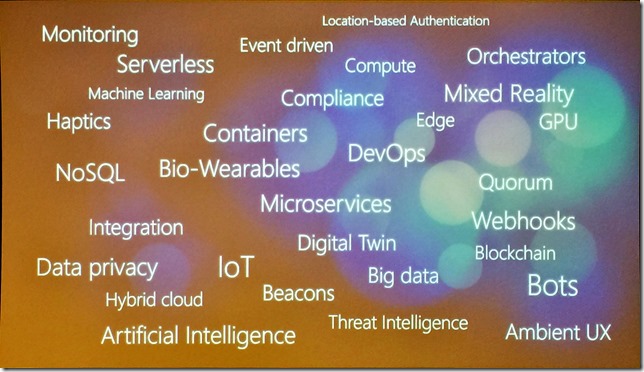
Integration has a part to play everywhere, he said now is the time, time to build new things, new solutions.
Furthermore, he went as far as to say that integration is now transformational, creating new revenue streams and services, reinventing the way we do business, but security is critical.
We need to be using Azure to do things differently; in a productive way, a hybrid way, an intelligent way, and a trusted way.
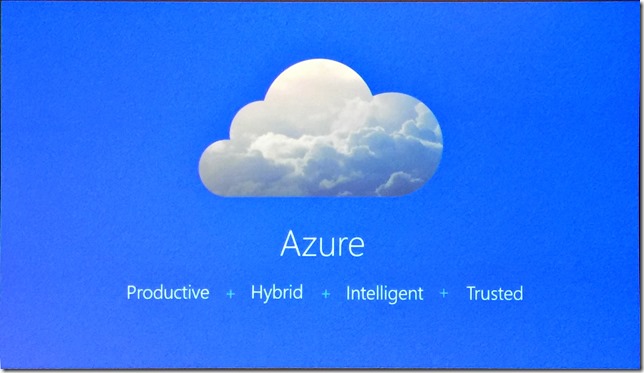
He spoke about the reach of Azure with an unparalleled capability to reach a global audience with 42 Azure regions, providing a global reach for global business, and a great fact, 20% of all power for Ireland is used in North Europe data centre!
He showed a great video about what a data centre looks like which gave a glimpse in to just how impressive the Azure cloud is.
But Azure is also a Trusted Cloud.

Azure has more certifications than any rival cloud provider, and provides a guarantee that regional data stays in the region and fails over across paired regions. Germany and China have specific data requirements so their data has even more protections.
Scott then shared that 90% of Fortune 500 companies use Azure.
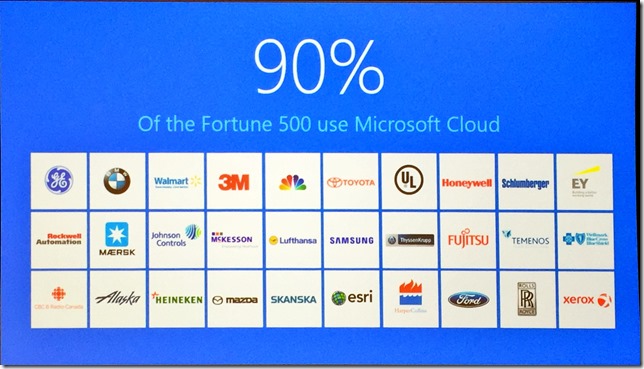
Time for another video, this one on customers using Azure including Asos, Dominos, Rockwell Automation and Geico.
Scott calls out integration again as the enabler of all these scenarios, one of the most critical components of the overall stack that delivers the value.
Next up is a great summary slide that shows the technology at play in Microsoft Azure across tools, advanced workloads and core infrastructure.
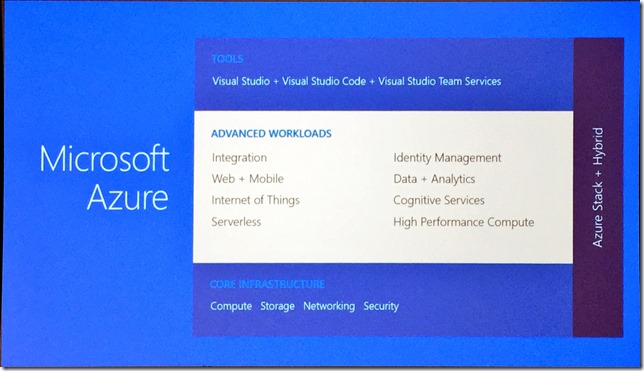
Integration is an important part of this, as is hybrid cloud.
Time for Scott to do some demos and showcase some integration scenarios.
The first demo is a backend solution driven by AI and data to create workflows. In this demo we see a Twitter analysis Logic App that monitors social networks, uses Cognitive Services to detect sentiment and perform key phrase extraction. The phrases are then analysed in a Function, and rows added to a PBI dataset.
The final part of the puzzle is sending a message to Microsoft Teams if the sentiment < 0.3 and creating a case in Dynamics 365 for support follow up.
This solution is live and used right now, Azure Support is currently able to reach out within three and a half minutes to follow up when negative sentiment is detected.
One curiosity was when showing Microsoft Teams, it clearly showed that not everything that seems negative is negative!
The second demo was based on a customer visit, a fitness organisation, and was built within the customer meeting and demonstrated Azure’s ability to solve real world problems and address pain points.
The demo used a PowerApp to take a picture, then use the Face API in Cognitive Services to do gym sign up and check in.
Now back to the slides, integration combined with other services provides much more possibility, and is better than a pure integration play.
Another quick demo showing how to create a new database, then talking about the capabilities of SQL Database including Point In Time recovery, and recommendations for optimising and auto tuning.
This was then extending to talk about SQL Injection and how the SQL Database service has threat analytics built in and how it can automatically block or take other actions as required when it perceives a threat.
Scott moved on to Virtual Machines and showed how to manage them, including the capability to manage multiple computers at once, you can look at Update management (patch management), and look at compliance of VM patching including Windows, Linux and non-Azure computers.
Using VM Inventory allows visibility on what VMs there are and their capabilities, then looking at Change tracking to show what has changed, files, registry settings, software and also supports managing multiple VMs at once making operators more efficient.
All of these demos really allow Scott to show that Azure has such a rich set of features with such a huge breadth.
Back to the core message to finish, integration is at the centre for connecting things together, and we can do it productively to deliver quickly, we can do it in a hybrid way to join cloud and on-premises, we can do it intelligently using AI and Cognitive Services and we can do it in a trusted way on a cloud that is compliant and secure.
With that Scott wrapped up and the first day concluded at Integrate 2017 USA, a day full of knowledge, information and humour.
Check out the recap of the events on
Day 1,
Day 2 and
Day 3 at Integrate 2017 USA.
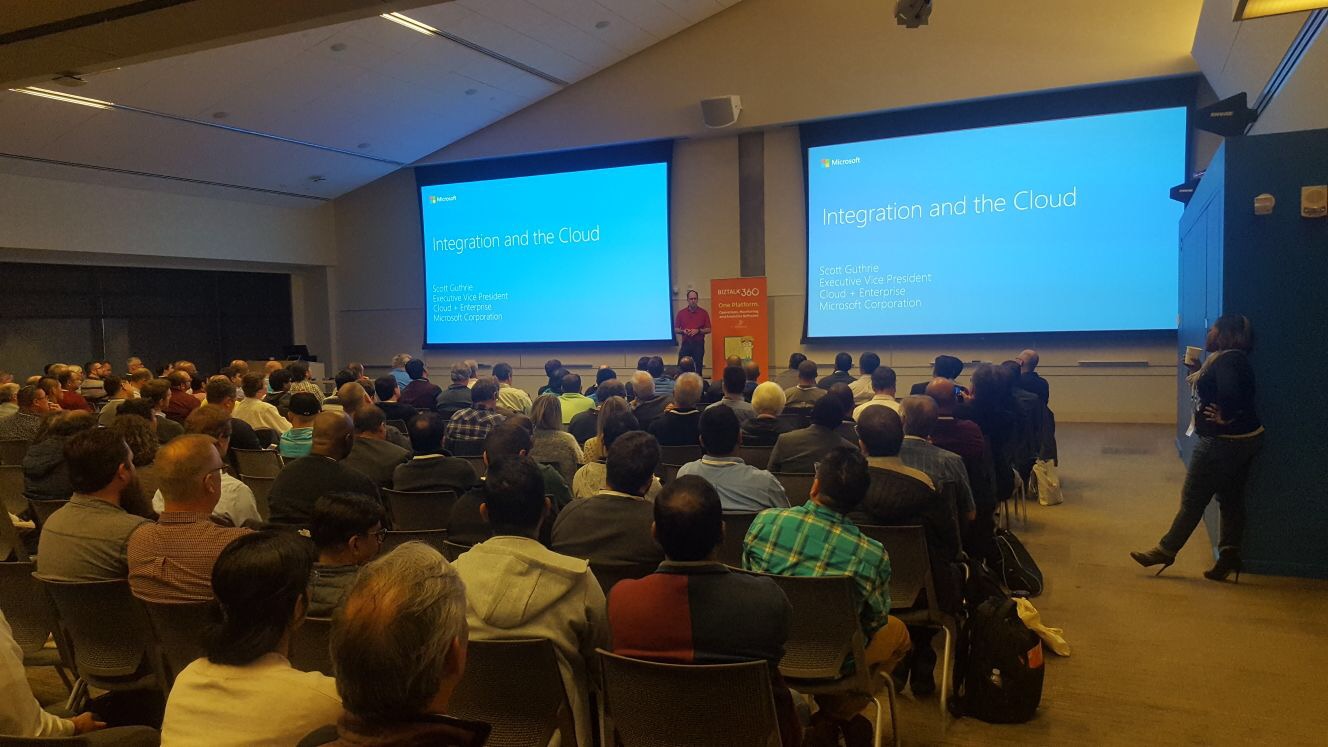
 He started by asking the question, what are the big opportunities for integration?
He echoed Jim’s sentiment earlier in the day that integration is the glue and an essential part of any enterprise solution.
As Integrate 2017 USA is a technical conference, he wanted to show some buzzwords and terms.
He started by asking the question, what are the big opportunities for integration?
He echoed Jim’s sentiment earlier in the day that integration is the glue and an essential part of any enterprise solution.
As Integrate 2017 USA is a technical conference, he wanted to show some buzzwords and terms.
 Integration has a part to play everywhere, he said now is the time, time to build new things, new solutions.
Furthermore, he went as far as to say that integration is now transformational, creating new revenue streams and services, reinventing the way we do business, but security is critical.
We need to be using Azure to do things differently; in a productive way, a hybrid way, an intelligent way, and a trusted way.
Integration has a part to play everywhere, he said now is the time, time to build new things, new solutions.
Furthermore, he went as far as to say that integration is now transformational, creating new revenue streams and services, reinventing the way we do business, but security is critical.
We need to be using Azure to do things differently; in a productive way, a hybrid way, an intelligent way, and a trusted way.
 He spoke about the reach of Azure with an unparalleled capability to reach a global audience with 42 Azure regions, providing a global reach for global business, and a great fact, 20% of all power for Ireland is used in North Europe data centre!
He showed a great video about what a data centre looks like which gave a glimpse in to just how impressive the Azure cloud is.
But Azure is also a Trusted Cloud.
He spoke about the reach of Azure with an unparalleled capability to reach a global audience with 42 Azure regions, providing a global reach for global business, and a great fact, 20% of all power for Ireland is used in North Europe data centre!
He showed a great video about what a data centre looks like which gave a glimpse in to just how impressive the Azure cloud is.
But Azure is also a Trusted Cloud.
 Azure has more certifications than any rival cloud provider, and provides a guarantee that regional data stays in the region and fails over across paired regions. Germany and China have specific data requirements so their data has even more protections.
Scott then shared that 90% of Fortune 500 companies use Azure.
Azure has more certifications than any rival cloud provider, and provides a guarantee that regional data stays in the region and fails over across paired regions. Germany and China have specific data requirements so their data has even more protections.
Scott then shared that 90% of Fortune 500 companies use Azure.
 Time for another video, this one on customers using Azure including Asos, Dominos, Rockwell Automation and Geico.
Scott calls out integration again as the enabler of all these scenarios, one of the most critical components of the overall stack that delivers the value.
Next up is a great summary slide that shows the technology at play in Microsoft Azure across tools, advanced workloads and core infrastructure.
Time for another video, this one on customers using Azure including Asos, Dominos, Rockwell Automation and Geico.
Scott calls out integration again as the enabler of all these scenarios, one of the most critical components of the overall stack that delivers the value.
Next up is a great summary slide that shows the technology at play in Microsoft Azure across tools, advanced workloads and core infrastructure.
 Integration is an important part of this, as is hybrid cloud.
Time for Scott to do some demos and showcase some integration scenarios.
The first demo is a backend solution driven by AI and data to create workflows. In this demo we see a Twitter analysis Logic App that monitors social networks, uses Cognitive Services to detect sentiment and perform key phrase extraction. The phrases are then analysed in a Function, and rows added to a PBI dataset.
The final part of the puzzle is sending a message to Microsoft Teams if the sentiment < 0.3 and creating a case in Dynamics 365 for support follow up.
This solution is live and used right now, Azure Support is currently able to reach out within three and a half minutes to follow up when negative sentiment is detected.
One curiosity was when showing Microsoft Teams, it clearly showed that not everything that seems negative is negative!
The second demo was based on a customer visit, a fitness organisation, and was built within the customer meeting and demonstrated Azure’s ability to solve real world problems and address pain points.
The demo used a PowerApp to take a picture, then use the Face API in Cognitive Services to do gym sign up and check in.
Now back to the slides, integration combined with other services provides much more possibility, and is better than a pure integration play.
Another quick demo showing how to create a new database, then talking about the capabilities of SQL Database including Point In Time recovery, and recommendations for optimising and auto tuning.
This was then extending to talk about SQL Injection and how the SQL Database service has threat analytics built in and how it can automatically block or take other actions as required when it perceives a threat.
Scott moved on to Virtual Machines and showed how to manage them, including the capability to manage multiple computers at once, you can look at Update management (patch management), and look at compliance of VM patching including Windows, Linux and non-Azure computers.
Using VM Inventory allows visibility on what VMs there are and their capabilities, then looking at Change tracking to show what has changed, files, registry settings, software and also supports managing multiple VMs at once making operators more efficient.
All of these demos really allow Scott to show that Azure has such a rich set of features with such a huge breadth.
Back to the core message to finish, integration is at the centre for connecting things together, and we can do it productively to deliver quickly, we can do it in a hybrid way to join cloud and on-premises, we can do it intelligently using AI and Cognitive Services and we can do it in a trusted way on a cloud that is compliant and secure.
With that Scott wrapped up and the first day concluded at Integrate 2017 USA, a day full of knowledge, information and humour.
Check out the recap of the events on Day 1, Day 2 and Day 3 at Integrate 2017 USA.
Integration is an important part of this, as is hybrid cloud.
Time for Scott to do some demos and showcase some integration scenarios.
The first demo is a backend solution driven by AI and data to create workflows. In this demo we see a Twitter analysis Logic App that monitors social networks, uses Cognitive Services to detect sentiment and perform key phrase extraction. The phrases are then analysed in a Function, and rows added to a PBI dataset.
The final part of the puzzle is sending a message to Microsoft Teams if the sentiment < 0.3 and creating a case in Dynamics 365 for support follow up.
This solution is live and used right now, Azure Support is currently able to reach out within three and a half minutes to follow up when negative sentiment is detected.
One curiosity was when showing Microsoft Teams, it clearly showed that not everything that seems negative is negative!
The second demo was based on a customer visit, a fitness organisation, and was built within the customer meeting and demonstrated Azure’s ability to solve real world problems and address pain points.
The demo used a PowerApp to take a picture, then use the Face API in Cognitive Services to do gym sign up and check in.
Now back to the slides, integration combined with other services provides much more possibility, and is better than a pure integration play.
Another quick demo showing how to create a new database, then talking about the capabilities of SQL Database including Point In Time recovery, and recommendations for optimising and auto tuning.
This was then extending to talk about SQL Injection and how the SQL Database service has threat analytics built in and how it can automatically block or take other actions as required when it perceives a threat.
Scott moved on to Virtual Machines and showed how to manage them, including the capability to manage multiple computers at once, you can look at Update management (patch management), and look at compliance of VM patching including Windows, Linux and non-Azure computers.
Using VM Inventory allows visibility on what VMs there are and their capabilities, then looking at Change tracking to show what has changed, files, registry settings, software and also supports managing multiple VMs at once making operators more efficient.
All of these demos really allow Scott to show that Azure has such a rich set of features with such a huge breadth.
Back to the core message to finish, integration is at the centre for connecting things together, and we can do it productively to deliver quickly, we can do it in a hybrid way to join cloud and on-premises, we can do it intelligently using AI and Cognitive Services and we can do it in a trusted way on a cloud that is compliant and secure.
With that Scott wrapped up and the first day concluded at Integrate 2017 USA, a day full of knowledge, information and humour.
Check out the recap of the events on Day 1, Day 2 and Day 3 at Integrate 2017 USA.